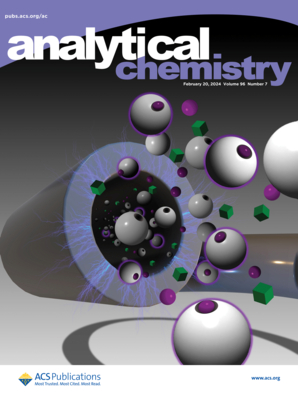设计荧光纳米传感器的高通量方法
IF 6.7
1区 化学
Q1 CHEMISTRY, ANALYTICAL
引用次数: 0
摘要
光学传感器是识别和成像(生物)分子的强大工具。由于其光电特性,纳米材料经常被用作构件。为了将与分析物的化学作用转化为光信号,必须优化表面化学与纳米材料光物理之间的相互作用。对这些方面的了解为量身定制具有最佳性能的传感器带来了重大机遇。然而,这就需要创造和探索多种化学变体的方法。事实上,目前的许多方法在吞吐量方面都受到了限制。这影响了可研究的化学设计空间、机器学习方法的应用以及对基本机理的理解。本文概述了创建和识别分子纳米传感器的选择限制和合成限制方法。讨论了瓶颈问题,并强调了非经典识别策略的机会,如电晕相分子识别以及对高通量和可扩展性的要求。荧光碳纳米管是传感器的强大构件,其巨大的化学设计空间使其成为高通量方法的理想平台。因此,荧光碳纳米管是本文的重点,但本文的见解也适用于任何纳米传感器系统。总之,本文旨在为克服当前纳米传感器领域的挑战提供一个全新的视角。本文章由计算机程序翻译,如有差异,请以英文原文为准。

High-Throughput Approaches to Engineer Fluorescent Nanosensors
Optical sensors are powerful tools to identify and image (biological) molecules. Because of their optoelectronic properties, nanomaterials are often used as building blocks. To transduce the chemical interaction with the analyte into an optical signal, the interplay between surface chemistry and nanomaterial photophysics has to be optimized. Understanding these aspects promises major opportunities for tailored sensors with optimal performance. However, this requires methods to create and explore the many chemical permutations. Indeed, many current approaches are limited in throughput. This affects the chemical design space that can be studied, the application of machine learning approaches as well as fundamental mechanistic understanding. Here, an overview of selection-limited and synthesis-limited approaches is provided to create and identify molecular nanosensors. Bottlenecks are discussed and opportunities of non-classical recognition strategies are highlighted such as corona phase molecular recognition as well as the requirements for high throughput and scalability. Fluorescent carbon nanotubes are powerful building blocks for sensors and their huge chemical design space makes them an ideal platform for high throughput approaches. Therefore, they are the focus of this article, but the insights are transferable to any nanosensor system. Overall, this perspective aims to provide a fresh perspective to overcome current challenges in the nanosensor field.
求助全文
通过发布文献求助,成功后即可免费获取论文全文。
去求助
来源期刊

Analytical Chemistry
化学-分析化学
CiteScore
12.10
自引率
12.20%
发文量
1949
审稿时长
1.4 months
期刊介绍:
Analytical Chemistry, a peer-reviewed research journal, focuses on disseminating new and original knowledge across all branches of analytical chemistry. Fundamental articles may explore general principles of chemical measurement science and need not directly address existing or potential analytical methodology. They can be entirely theoretical or report experimental results. Contributions may cover various phases of analytical operations, including sampling, bioanalysis, electrochemistry, mass spectrometry, microscale and nanoscale systems, environmental analysis, separations, spectroscopy, chemical reactions and selectivity, instrumentation, imaging, surface analysis, and data processing. Papers discussing known analytical methods should present a significant, original application of the method, a notable improvement, or results on an important analyte.
 求助内容:
求助内容: 应助结果提醒方式:
应助结果提醒方式:


